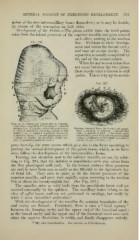Page 541 - My FlipBook
P. 541
GENERAL ACCOUNT OF EMBRYONIC DEVELOPMENT. 551 ;
union of the two intermaxillary bones themselves ; or it may be double,
by reason of the non-union on both sides.
Development of the Palate.—The plates which form the hard palate
arise from the lateral processes of the superior maxilla and grow toward
each other, uniting in the median
FiG^96. Previous to their develop-
lii^e.
ment and union the buccal cavity
and nose are as one cavity. The
separation is usually completed by
the end of the second month.
When for any reason union does
not occur between the t\vo plates,
there results what is known as clejit
it palate. This is very apt to accom-
-—— ^
Face of an Embryo of Twenty-five to Twenty- : ^^^^^S ^^?y
eight Days imagjiified fifteen times): 1, frontal
promiuence; 2, S, right and left olfactory fossse Embryo removed from the Ovum, and magni-
;
4, inferior maxillary tubercles, united' in the fied: a, amnion; 6, yolk-sac; c, mandibular
middle line; 5, superior maxillary tubercles; arch; d, maxillary arch; e, hyoidean arch;
6, mouth or fauces: 7, second pharyngeal arch behind this are the first and second branchial
;
8, third; 9, fourth; 10, primitive ocular ves- arches ;/. rudiment of fore limb; icle; 11, primitive auditory vesicle. vesicle; h, eye; /, heart (X 5)-
pany hare-lip, the same causes which give rise to the latter operating to
prevent the normal development of the palate bones, which, as we have
seen, follow the development of the intermaxillary bones.
Turning our attention now to the inferior maxilla, we see, by refer-
ring to Fig. 294, that the inferior or mandibular arch also arises from
the first pharyngeal arch (?)icZ). In the human embryo these processes
are said to have been seen as early as the fifteenth to the eighteenth day
of foetal life. They arise in pairs, as do the lateral processes of the
superior maxilla, and grow very rapidly, union occurring in the median
line at about the twenty-eighth day. (See Fig. 296.)
The maxillae arise as solid buds from the mesoblastic layer, and are
covered externally by the epiblast. The maxillary bones belong to the
class of splint bones, and are not preformed in cartilage, but ossify by
what I term interstitial ossification.^
With the development of the maxillae the anterior boundaries of the
"
oral cavity are formed. Posteriorly, there is seen a " foetal septum
between the forming cavity and the upper end of the intestinal canal
as the buccal cavity and the upper end of the intestinal canal near each
other the septum diminishes in width, and finally disappears entirely.
'^ My own classification. See section on Calcification.


